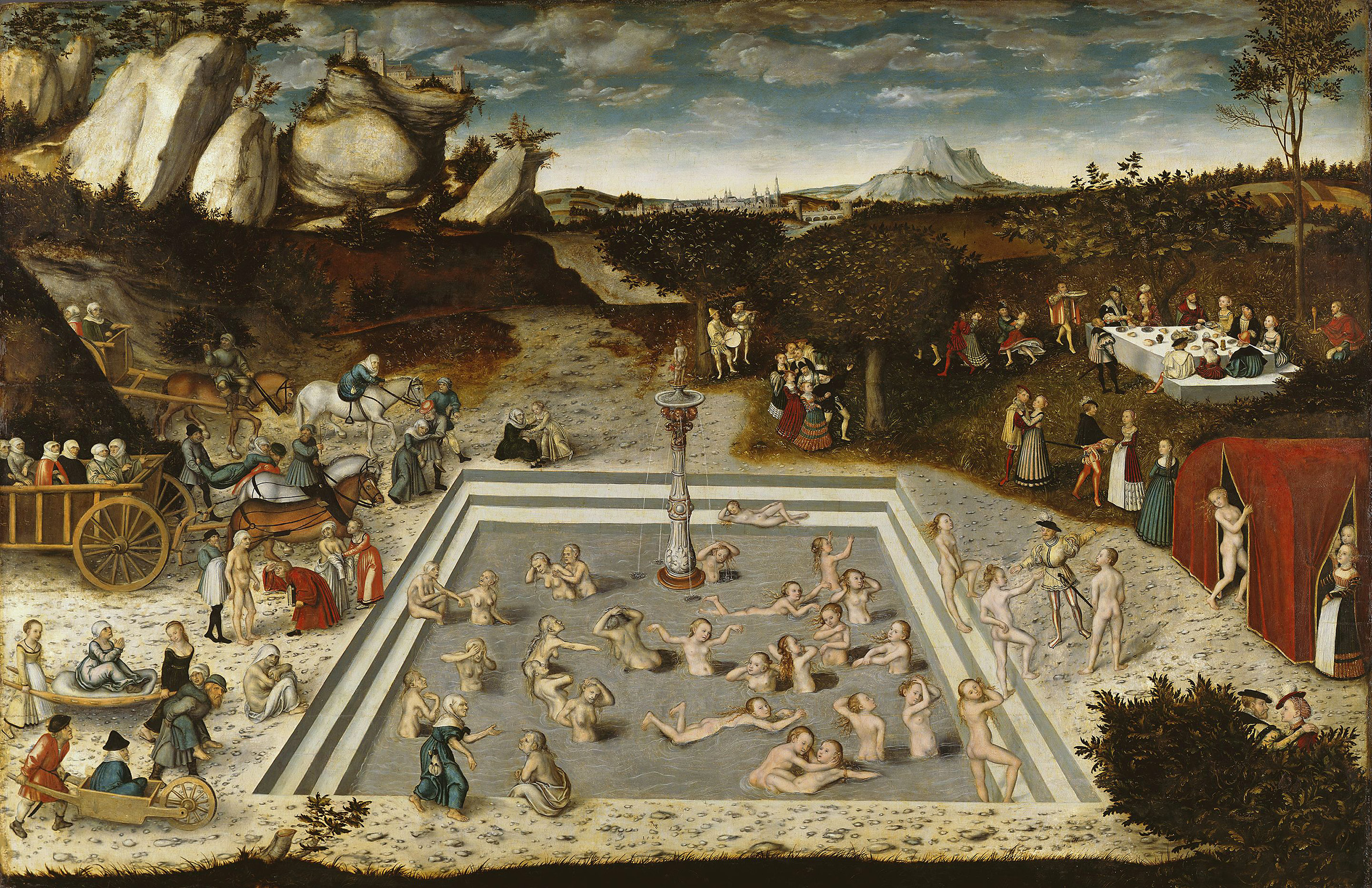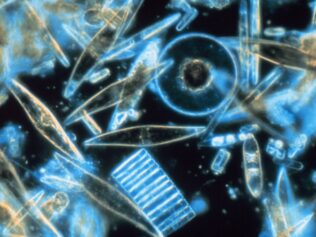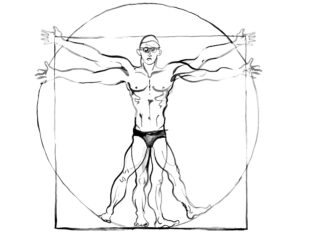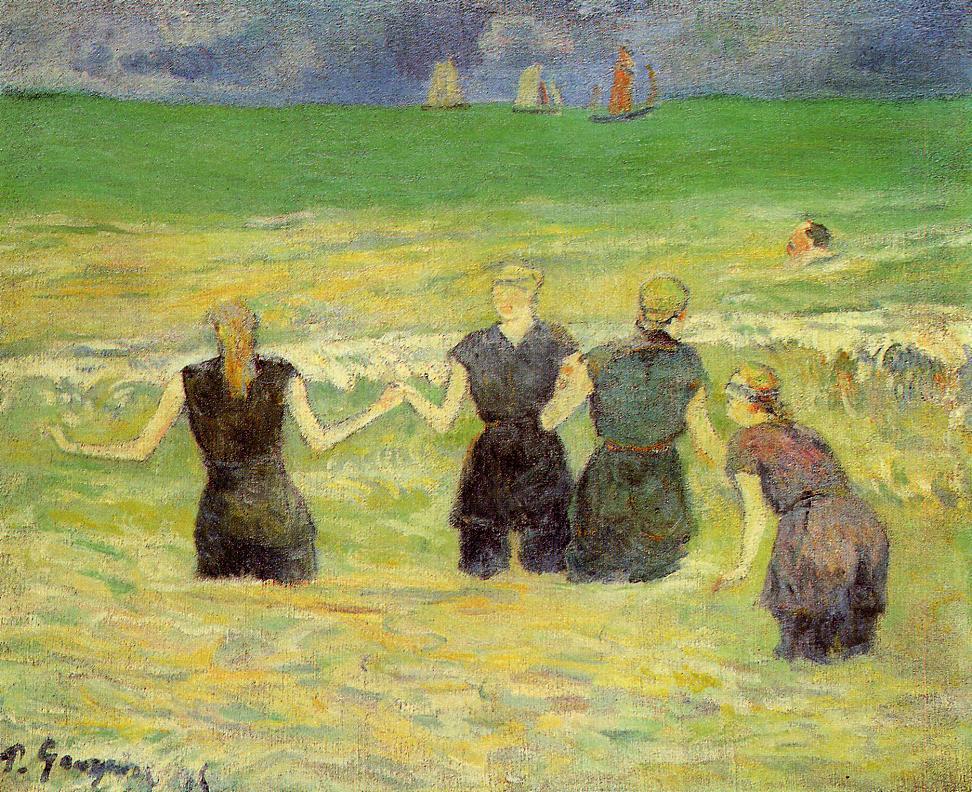
The universality of the flood myth is quite astonishing, as was the astute intuition of our ancestors who viewed water as the beginning of all life.
Natural considerations in part shape the culture of each society. The sun will have a different meaning to people exposed to scorching heat pouring from the sky when compared to the inhabitants of Subarctic regions. For the first group, the sun can be a destructive force (in India, it is the moon that is associated with the source of life), while their vision of paradise is a cool and humid place (in the case of ancient Middle Eastern religions).
Yet if we think about water – its imagery in established mythologies and the meaning it has in rituals – we could risk making a few general assumptions. In a very obvious sense, we need water to live, no matter which part of the planet we inhabit. It also has an existential profundity which manifests itself in various ways in beginning-of-the-world myths, in the symbolism of baptism, in ritual ablutions or apocalyptic visions of a flood.
We need to remember that religious symbols are a kind of metaphor: they try to convey their meaning with the help of something that does not directly represent them, but rather ‘brings them to mind’. However, these symbols are not a metaphor in the proper sense, if translating the meaning of a metaphor into a non-metaphorical language is feasible at all in the first place. We are never able to exhaustively extract symbolic meanings; we can only speak of approximations here (if these meanings have been depleted or the symbol is extinct, it ceases to be a symbol).
Water can mean anything – it can be the source of life or it can be a grave. It is sometimes associated with masculinity (in our cultural realm, the deities of capricious and menacing seas are male, like Poseidon or Neptune), or with femininity or the maternal element (each spring in the Greek world had its nymph; perhaps water bubbling from the underground brought an image of human birth to ancient minds). The philosopher Gaston Bachelard named several symbolic categories of water that could be found in poetry and myths: standing water, running water, bright water, sweet and salty water, spring water, cleansing water, glimmering water, deep water and frisky water.
Shapeless form
Due to its physical properties, water provides a wealth of meanings, but it has one elementary feature: its lack of form and shapelessness. In his book Patterns in Comparative Religion, Mircea Eliade sees these physical properties as the key to interpreting the symbolism of water in myths and rituals – it lacks shape, it is the source of all forms, the leaven of everything that lives, that sprouts. If water washes over an object, it takes away its shape and annihilates it in that sense, yet at the same time, it is the source of all rebirth.
As we can recall from the biblical Book of Genesis, before God created the world, “[…] the earth was formless and empty, darkness was over the surface of the deep, and the Spirit of God was hovering over the waters.” (Genesis 1:2). A similar (correct from the viewpoint of modern theories) intuition, which views water as the source of life, appears in many mythologies throughout the world. In Hindu mythology, Narayana floated over the primaeval waters, and from his navel grew a cosmic tree, which was changed to a lotus in later traditions, and from it, Brahma was born. According to a different tradition, Vishnu freed Prithvi, the goddess of Earth, who was imprisoned by a demon at the bottom of the ocean; by pulling her out of the waters, Vishnu initiated the creation of our world (this story appears in a number of texts, as well as in the Mahabharata). In the Popol Vuh, the holy book of one of the Maya peoples, at the beginning of times there was only silence and the sea, which the gods in the form of glittering beings inhabited. Native Americans often believe that at the beginning of times, a small animal (such as a turtle, otter or muskrat) played a key role, by taking mud out of the water, a little at a time, which then accumulated until the world was created. The Yuma tribe in America tells a fascinating myth about the Creator, Almighty Father, who had no name and no body and inhabited the deep waters for centuries, until he finally emerged from them and led to the creation of the cosmos. A number of variations regarding a cosmic egg laid in the prehistoric ocean from which our current reality hatched is quite common in several corners of the globe (in Indonesia as well as Siberia).
The mythologies of great civilizations of the East describe a cosmos that emerges from the primaeval chaos, which is sometimes defined using terms making reference to the element of water. This is the case of the Egyptian Nun, Babylonian Apsu or the Chinese Hundun. (Perhaps some of you might be interested to know how the symbol of water is transcribed in the oldest known writing systems in the world. The Egyptian hieroglyph for water is a triple zig-zag line, while the Sumerian system depicts the element as two vertical wavy lines.)
And, of course, life-giving rain absolutely had to have its own mythological interpretation. Raindrops were associated with divine semen that fertilized the soil; one of Indra’s nicknames is the ‘Bull of the Earth’. In the mythology of the Trobrianders, studied by Bronisław Malinowski, Bolutukwa, the mother of a legendary hero, became a woman only because of drops falling from a stalactite. Biblical psalms give thanks to God for how “He covers the sky with clouds; He supplies the earth with rain […].” (Psalm 147:8).
Palaces in the abyss
In East Asian beliefs, dragons live in palaces situated on the bottom of deep seas and in the clouds, and are also responsible for creating the latter (unlike our cultural realm, in East Asia dragons are beings of infinite wisdom and are key to the development of civilization). The Chinese dragon Jing collects water in the clouds and controls rainfall. Thus one of the ancient methods of inducing rain involved creating a likeness of Jing. It’s also quite fascinating that the same theme appeared in Polish folklore – in the 1930s, ethnographers recorded a statement made by an inhabitant of the village of Gnojno in the Mazovia region, who claimed to have seen a dragon swallowing a cloud.
The history of religion has seen a tremendous number of animals as well as fabulous creatures that are associated with the element of water. Nagas, creatures on a higher level of evolution than humans, are regarded with great reverence in India and Tibet. These snake-like beings traditionally guard ponds, wells and springs; they live in underwater palaces where they collect sea treasures, pearls, shells and corals. As a matter of fact, Naga princesses were proudly presented in human dynasty lines. Certain traditions say that Buddha, having concluded that people were not ready for his teachings, first passed them to the Nagas who in turn waited several centuries to finally convey that holy knowledge to the sage Nagarjuna, a monk who probably lived in the 2nd century CE and played a key role in the development of Buddhist philosophy (today’s scientists consider him to be a predecessor of Immanuel Kant, Ludwig Wittgenstein, Jacques Derrida, etc.).
Quoting the words of the prominent Indologist Heinrich Zimmer, since Vedic times in India waters constitute a “tangible manifestation of the godly essence.” In fact, water is considered to be the seat of the gods. Even in our times, a pot or jug filled with water is used in popular and simple ritual forms as a representation of a deity. Tertullian, a Christian theologian living in the 2nd and 3rd centuries, used theological argumentation to exalt the element of water over the element of earth. In reference to the fragment of the Book of Genesis quoted above, he noted that the Holy Spirit chose water as the first place to be in. Although he acknowledged that the earth constituted the substance of creation, he was of the opinion that it would have been useless if it hadn’t been wet and damp. The Holy Spirit brought forth life in the water first so we would stop wondering why ‘life today is born through baptism’.
Cybele bathes
The concept of the emergence of life from water and through water – as explained by the great cosmogonic myths – is quite visible in the symbology of baptism, which can be interpreted as the transposition of the idea from the cosmic layer to the human layer. According to theologians living in the first few centuries after Christ, baptism not only cleanses from sins, but also constitutes actual birth, or the birth to spiritual life. Saint John Chrysostom compared baptism directly to death – immersing one’s head in water was. in a way, like entering a grave and these actions led to the birth of a ‘new human’.
We could therefore classify baptism as an initiation ritual. In that sense, we can compare it to initiations on the islands of Fiji, during which young men are ritually washed in water with black paint symbolizing death before they enter adulthood. On the Tonga islands, on the other hand, boys are painted white, which is to reflect the ‘blackness of childhood’. The paint is then washed off, the boys receive new clothes and also become ‘new people’. Here we should also note that the Greek goddess Hera would bathe in the spring of Kanathos to renew her virginity.
It’s quite clear that the meaning of ritual ablution is not limited to matters of hygiene. As we know, ablutions play an essential role in everyday Muslim life. Islamic teachings state that Allah sends water from the heavens to help believers free themselves from interference by evil spirits. If water is lacking, sand is used instead. Bathing in the Ganges plays a similar role – the river flows from the beard of Shiva and ablution in this case washes off ‘karmic debt’. Ablutions appear in other realities as well: the Egyptian Pyramid Texts, which among other things include practical tips for the pharaoh for each stage of his journey through the netherworld, speak of a ritual purification in water by the goddess Kebechet.
We should also note that water is present when you enter Christian churches (‘holy water’), and Muslim and Zoroastrian sanctuaries. Priests of various faiths need to wash their hands or entire bodies during different religious ceremonies. Brahmin priests rinse their mouths out with water even for simple sacrificial rites. As we read in Śataphata-brahmana: “The reason why he touches water, is that man is (sacrificially) unpure [… ] For water is indeed (sacrificially) pure. Having become purified through the purifying one […] he passes from the men to the gods.” This is where we start to approach the complicated anthropological issue of ‘purity’ and ‘flaw’ (ritual, ethical). But let’s just stop at that and make do with the fact that immersing oneself in water is one of the ways of achieving symbolic purification.
We still need to mention the case of the only Gnostic sect which made it to our times, the Mandaeans. In their case, ritual washing has reached spectacular levels. They dig pools near rivers that they call Yardenas (after the River Jordan), and water flows via trenches to sanctuaries built right next to them (these structures have nothing inside, no decorations and no objects). Baptism, which involves full immersion in the water, is performed at least once a week, or even more frequently, in cases of defilement, sin, etc. Mandaeism forbids the drinking of tap water or bottled water, as it is not real, live water. Live water flows in rivers and springs only. Needless to say, it is not Christ who plays a key role in their beliefs (he is actually deemed a false prophet), but John the Baptist.
In the ancient world, figures of deities also took ritual baths. Figures of Cybele, the Phrygian goddess of fertility, would be bathed in a river or a pond, and the purpose of such a bath was to regenerate the dried-out forces represented by the goddess, which in turn was to guarantee a successful harvest. We know that the figures of Athena and Aphrodite were also bathed in a similar manner. In spite of resistance from the Church, these ‘pagan’ rites survived until the 19th and 20th centuries in those places where a cross or an image of the Mother of God is immersed in water to protect against drought.
Ice swimming
The benign significance of water is also manifested in various therapies and in the work of healers. The concept is the same – contact with water dilutes the illness and dilutes the ‘form’ that has been degenerated in order to restore initial health. We could go on and on for hours on end about all the healing streams, springs and ‘fountains’ that have been reported in Poland. I’m also sure that many of our readers can recall the rather unpleasant childhood custom of pouring cold water over the head of a ‘hysterical’ child.
We can also find similar quasi-ritual meanings in balneotherapy or ice swimming, regardless of any scientifically confirmed positive effects of such practices. Wim Hof, a Dutchman and well-known promoter of ice swimming in our times, interchangeably uses scientific and yoga terminology even when he speaks of a cold shower: cold water cools down the body several times more vigorously than air, it regenerates the body and mind, cleanses, releases hidden energy, heals, etc.
A sip from the fountain of knowledge
There has been many a revolution and change in the history of religion, but it’s quite interesting that the cult of holy springs has enjoyed a certain continuity. Christian theologists were unsuccessful in their fight against ‘pagan’ remains of similar customs, as evidenced by numerous church prohibitions. Yet after many centuries of threats of punishment, the Church changed its tactics and Christianized water cults. For hundreds of years, peasants in the Aubrac mountains, near the Lac de Saint-Andéol, offered a sacrifice of used clothes, cakes and cheese by throwing them into the water. Father Parthenius did not manage to force them to abandon these practices with the help of theological arguments. In the end, he built a church near the lake. People started bringing the sacrifices there rather than throwing them into the water.
In prehistoric times, in the area of what is today the town of Marsala in Sicily, there was a cult organized around a flooded cave. People would go there for purposes of divination among other things, so when the Greeks started colonizing the region, the place was associated with Sibyl, the mythical prophet. We also come across the phenomenon of assigning powers of divination to springs in other testimonies from the world of ancient Greece. Iamblichus mentions a priest in Colophon who would drink water from a mysterious spring before each prophecy. And when Christianity came along, the cave started to be a place of the cult of… who else, but Saint John the Baptist. A church consecrated to him was built there in the 16th century, which to this day is visited by believers and tourists.
The holy healing springs are surely associated with the concept of life-giving waters and waters of immortality flowing in the underworld, which have their beginnings in the world of the dead, as was the case in the oldest known myth of humanity, that of the goddess Inanna. The most important Old Germanic god Odin-Woden also drank the water of wisdom that flowed through the roots of the tree representing the universe (to do that, he sacrificed his own eye, which according to old Scandinavian beliefs swims in that water to this day).
The deceased are thirsty
Another interesting fact is that according to a number of beliefs, the deceased also felt thirst. The ancient Greeks shared this view, and on the occasion of the Anthesteria holiday they would pour water into graves. I mentioned at the beginning that the ecological context shapes the religious imagery of nations, therefore cultures threatened by drought performed libations for their dead.
This combination of the meaning of water with life leads to fascinating concepts according to which life itself is assessed as being negative, and above all as a never-ending chain of suffering. Ancient Pythagorean and Neoplatonic movements that professed the doctrine of reincarnation are such a case. According to Porphyry, the soul demands dampness (this thirst was quenched by pouring water into graves, for example), which should be understood as the longing of the soul for its next incarnation. Yet if the journey of souls is marked by inevitable suffering, then, in line with these concepts, the soul should rather be dried out to make rebirth in this world impossible and ensure liberation by letting the soul escape to a heavenly reality.
This rule of annihilating old forms to make way for the birth of new ones was dismally applied in various forms of religious violence. For example, Tatar bastards, being a manifestation of ‘impure’ life, would be drowned in muddy rivers to annul the ‘flaw’ caused by the very fact of their existence. According to Tacitus, Germanic peoples would drown individuals lacking bravery or manifesting laziness in mud and swamps. These behaviours should once again be interpreted as an attempt at ‘purification’, an effort to fix the cosmic error. In Scandinavian mythology, the giant Aegir (his name comes from the Germanic aquiaz, which we can associate with the Latin aqua) rules the seas and oceans, while his wife is the goddess Rán, who catches drowned people in her net. These captured people end up in a special land of the dead, which is the underwater seat of Rán; people offered as a sacrifice to the goddess are also guided there. Another interesting fact is that human sacrifices are also offered in Rán’s underwater abode.
Indeed, water reservoirs demanded live sacrifices. According to Homer, the Trojans threw horses into the river. Germanic peoples, Franks and Slavs threw animals in the water as well. Horses and oxen were offered as sacrifice to Poseidon and other gods of the sea. On the other hand, smaller sacrifices were offered when people needed to cross a river. Not only Indo-European peoples had such traditions – similar customs are also practiced by the Maasai in Africa, who throw bunches of grass into rivers, as well as the Bagando, who drop coffee beans into the water.
Drowned and reborn
The mythology surrounding the flood is the transposition of the system we’re discussing here to a cosmic and historic level – as a result of a flaw, sin or error, the gods annihilate the world of degenerated societies (and for some unknown reason, the punishment also falls on animals at the same time), so that they can be reborn again.
The universality of the story is worth emphasizing here, as it seems that Noah had many predecessors. The sage Utnapishtim, whom Gilgamesh visits to find immortality, saved himself and his wife along with some animals from a great flood sent by the gods. The oldest Sumerian text that mentions the flood is dated to 1750 BCE. Yet its interpretation has been quite difficult – it is unclear whether the flood was sent by the god Enki or the goddess Nintu, but there is no doubt that it was the work of an angered deity. As preserved clay tablets tell us, the flood was one of the reference points for Sumerian historians, who wrote of reigning monarchs, as well as mythical kings. Manu, the legendary first man of Hinduism and author of the first law code, was saved by Vishnu, who, having turned himself into a fish, took Manu into the Himalayas. The Greek god Zeus was said to have created a ‘bronze race’, that of impulsive, powerful people with souls made of iron, who did not eat flour. They were called the bronze race because their homes and weapons were made of bronze, they worked with bronze, and so on. Zeus decided that these people should be annihilated, so he sent torrent rains and streams falling from the skies. Deucalion, following the instructions of his father Prometheus, built a chest in which he and his wife, Pyrrha, took shelter. The pair came out of the chest after nine days when they touched solid ground on Mount Parnassus. Besides the two, only those who hid in the mountains survived. After the flood, Deucalion, who was in favour with the gods, asked them for a new humanity. The gods gave him rocks, which he was to toss behind his back. Men emerged from the rocks tossed by Deucalion, while women were created by the ones thrown by Pyrrha.
We can now see how that ancient story is being reborn in our times – because of the ecological sin and the sin of greed, humanity is causing icebergs to melt. Water will once again devour our civilization and all species of land animals; the world in the shape we know it will be washed away and perhaps new structures will be created.
A flood of desire
As I mentioned earlier, the meaning of a symbol can never be fully interpreted. It’s better to contemplate it in your imagination and experience it, rather than intellectually explain it. That’s why a fitting way to end this text would be to recap a certain amazing ancient myth that has survived to our times in various forms (Ramakrishna used it in his teachings in the 19th century). I believe it can provide a more profound understanding of the symbology of water.
Thanks to his tenacious asceticism, the god-sage Narada was able to ask the god Vishnu to grant his wish. He desired that Vishnu show him the magical power of his Maya, the creative power of reality (understood in later schools as an ‘illusion’, ‘play of illusions’ or ‘dream of reality’). Vishnu agreed and took Narada to the sun-scorched desert; after a short time, both started to feel thirsty. The god asked the ascetic to go to the nearby village and bring some water. Narada agreed, got up and went. He knocked on the door of the first house. The door opened and standing in it was the girl of his dreams. He fell in love immediately, and the feeling was mutual. Her family was happy to invite him inside – he was a holy man after all. Soon, Narada married the girl and went to live in the village. He led a happy life, and after his father-in-law’s death, he became the head of the family and had three loving children. 20 years passed and an exceptionally heavy wet season came. Rapid streams were flowing from the hills and water flooded the entire village. The flood swept away not only Narada’s house, not only his cattle, but his family as well. A terrified Narada tried to rescue them, battling the heavy rain and torrent, but his wife, captured by the water, cut him off at his knees. He drifted until the waves washed him up on a cliff. He was surrounded by nothing but muddy dirty water. His beloved family was dead. Narada was in a state of intolerable suffering and cried. Suddenly, he heard an oddly familiar voice: “My child, I’ve been waiting over half an hour for the water you went to fetch for me.” Narada took a better look around; he was no longer surrounded by water, but by the desert. Vishnu was bent over him with a cruel smile on his face and asked, “Do you understand the secret of my Maya now?”

Translated from the Polish by Mark Ordon










